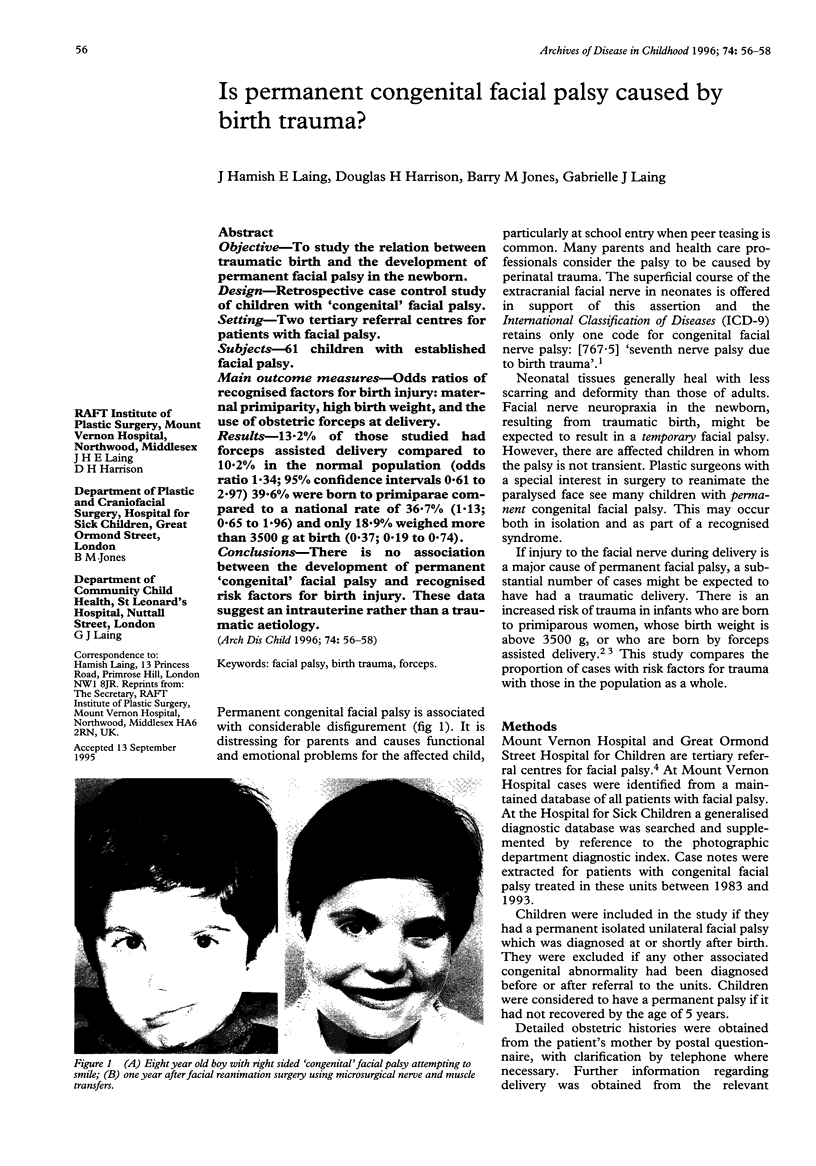Abstract
OBJECTIVE: To study the relation between traumatic birth and the development of permanent facial palsy in the newborn. DESIGN: Retrospective case control study of children with 'congenital' facial palsy. SETTING: Two tertiary referral centres for patients with facial palsy. SUBJECTS: 61 children with established facial palsy. MAIN OUTCOME MEASURES: Odds ratios of recognised factors for birth injury: maternal primiparity, high birth weight, and the use of obstetric forceps at delivery. RESULTS: 13.2% of those studied had forceps assisted delivery compared to 10.2% in the normal population (odds ratio 1.34; 95% confidence intervals 0.61 to 2.97) 39.6% were born to primiparae compared to a national rate of 36.7% (1.13; 0.65 to 1.96) and only 18.9% weighed more than 3500 g at birth (0.37; 0.19 to 0.74). CONCLUSIONS: There is no association between the development of permanent 'congenital' facial palsy and recognised risk factors for birth injury. These data suggest an intrauterine rather than a traumatic aetiology.
Full text
PDF


Images in this article
Selected References
These references are in PubMed. This may not be the complete list of references from this article.
- Falco N. A., Eriksson E. Facial nerve palsy in the newborn: incidence and outcome. Plast Reconstr Surg. 1990 Jan;85(1):1–4. doi: 10.1097/00006534-199001000-00001. [DOI] [PubMed] [Google Scholar]
- HEPNER W. R., Jr Some observations on facial paresis in the newborn infant: etiology and incidence. Pediatrics. 1951 Oct;8(4):494–497. [PubMed] [Google Scholar]
- Harrison D. H. Current trends in the treatment of established unilateral facial palsy. Ann R Coll Surg Engl. 1990 Mar;72(2):94–98. [PMC free article] [PubMed] [Google Scholar]
- Hibbard B. M., McKenna D. M. The obstetric forceps--are we using the appropriate tools? Br J Obstet Gynaecol. 1990 May;97(5):374–380. doi: 10.1111/j.1471-0528.1990.tb01822.x. [DOI] [PubMed] [Google Scholar]
- Illingworth R. S. Why blame the obstetrician? A review. Br Med J. 1979 Mar 24;1(6166):797–801. doi: 10.1136/bmj.1.6166.797. [DOI] [PMC free article] [PubMed] [Google Scholar]
- Kumari S., Bhargava S. K., Choudhury P., Ghosh S. Facial palsy in newborn: clinical profile and long-term follow-up. Indian Pediatr. 1980 Dec;17(12):917–922. [PubMed] [Google Scholar]
- Levine M. G., Holroyde J., Woods J. R., Jr, Siddiqi T. A., Scott M., Miodovnik M. Birth trauma: incidence and predisposing factors. Obstet Gynecol. 1984 Jun;63(6):792–795. [PubMed] [Google Scholar]
- Lin K. Y., Posnick J. C., al-Qattan M. M., Vajsar J., Becker L. E. Fetal nerve healing: an experimental study. Plast Reconstr Surg. 1994 Jun;93(7):1323–1333. [PubMed] [Google Scholar]
- Mili F., Edmonds L. D., Khoury M. J., McClearn A. B. Prevalence of birth defects among low-birth-weight infants. A population study. Am J Dis Child. 1991 Nov;145(11):1313–1318. doi: 10.1001/archpedi.1991.02160110105032. [DOI] [PubMed] [Google Scholar]
- Smith J. D., Crumley R. L., Harker L. A. Facial paralysis in the newborn. Otolaryngol Head Neck Surg. 1981 Nov-Dec;89(6):1021–1024. doi: 10.1177/019459988108900628. [DOI] [PubMed] [Google Scholar]




